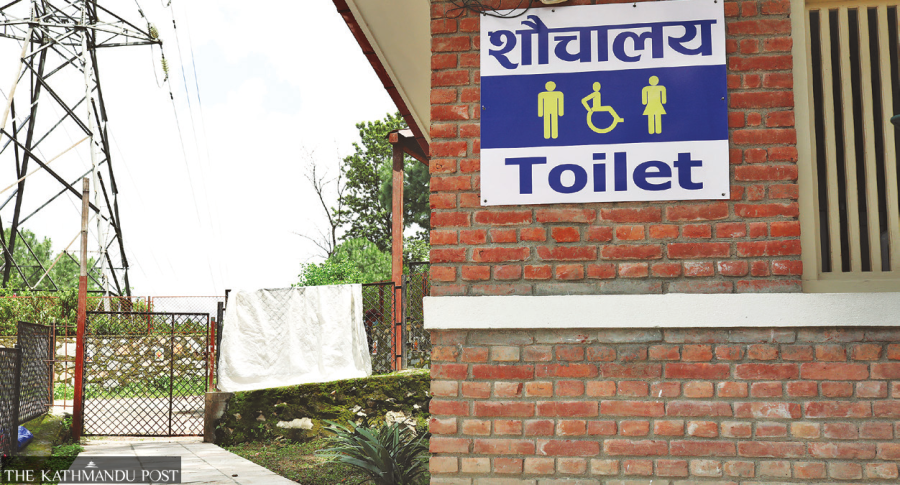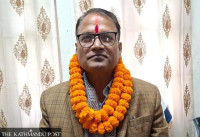National
The politics of public toilets
Experts and users say public toilet designs must evolve to become all-inclusive spaces with equitable access.
Aakriti Ghimire
Two options weigh Zion Magar down whenever he uses the public toilet—male or female.
“Most public toilets designated for males only have urinals, and they don’t have dustbins for disposal of sanitary pads,” said Magar, a volunteer at Unity for Change, an organisation working mainly for trans men, transgender persons who have transitioned from female to male. “On the other hand, I am subjected to hate and disgust in toilets designated for females.”
Magar is a trans man who says he is compelled to use women’s toilets, particularly during his periods, despite the unwanted attention he gets because of his outward appearance, which is stereotypically masculine.
“We need all-inclusive toilets. In some places, they write ‘others’. The moment I enter that toilet, I feel humiliated,” said the 21-year-old. “I want to be able to enter the ‘male’ bathroom, but I hope it also has pads and a dustbin and enough water.”
However, it isn’t just Magar whose access to public toilets is restrictive for various reasons. The needs of various individuals, such as trans individuals, persons with disabilities (such as wheelchair users and blind individuals), and new mothers, are neglected in almost all public and private toilets in Nepal by design, including the basic amenities required by default.
On Sunday, the newly elected Kathmandu Mayor Balendra Shah announced that the Metropolitan City will build “at least 10 new public toilets catering to the needs of men, women, LGBT (lesbian, gay, bisexual, transgender)” and people with disabilities.
While the mayor’s announcement signals a positive direction, especially for those who’ve been neglected by policy and design, there are concerns about whether their needs will be addressed appropriately and if minimum standards and best practices will be adopted.
“Toilet signages with the light attached will be installed in various places. But that doesn’t let a blind individual know where the toilet is,” said Suresh Chandra Neupane, president of the Nepal Association of the Blind (NAB). “There should at least be some sound indicating a toilet close by and tactile pavements that lead to toilets.”
The dearth of all-inclusive public toilets designed for accessibility is an indicator of larger urban planning failures that primarily neglect the quality of life. There are only 35 public toilets in Kathmandu Metropolitan City, according to a field survey by WaterAid Nepal and GUTHI, a nonprofit organisation that works in areas of water and sanitation.
Of these 35 public toilets, only a few are operational and most are in unusable conditions. They lack basic supplies like soap and water and are simply unhygienic with a bad stench. Instead of serving the public, the much-needed city infrastructure has become a source of nuisance and public health issues.
While accessibility remains a primary issue, poorly designed public toilets also affect the mobility of new mothers and parents alike. Amenities, particularly for new parents, such as child seats in toilets and changing stations have never been imagined by policymakers, without which many mothers and parents have to make difficult decisions.
“How long can a mother stay at home only with young kids? They need to get out and because of this difficulty, people either choose to stay home or leave babies at home,” said TM, a mother of two, whom the Post is identifying only with her initials at her request. “Not everyone is comfortable feeding in public… it took me a lot of courage with my second child to feed her outside using a cape. We need separate breastfeeding rooms too.”
The 32-year-old mother of two added, “Because I can tell for 100 percent that most mothers want to get out but because of these tiny things, and how they pose so many difficulties, many don’t even leave their homes.”
According to Guidelines on Sanitation and Health, published by the World Health Organization, toilet design, construction, management and use should be well-thought-out.
From the construction of toilets with durable materials to ensuring safety and privacy with the use of locks, the guidelines emphasise facilities for menstrual hygiene management.
Research also finds that public toilets are dysfunctional because of a myriad of reasons. The issues range from design, behaviour, public health, cleaning skills and methods, clean water, building maintenance, accessibility, norms and standards, legislation, research and development, and technologies to public education.
Public restrooms in more developed countries are not just architecturally sound but also have facilities ranging from changing stations for children, breastfeeding rooms, automatic flush, sensory detection-based facilities, soap dispensers, hand towels, and running hot and cold water.
With the new mayor in town, voters in Kathmandu are hopeful that the public toilets will see better days ahead. Water and sanitation experts have also praised Shah’s decision to emphasise the need for accessible toilets and stress meticulous efforts in designing and implementing toilets—calling it “Bold and Balen.”
“The initiative that Balen Shah has taken is very commendable. But many things need to be taken into consideration,” said Prakash Amatya, the CEO of Aerosan Sustainable Sanitation, a social enterprise started under Canada-based NGO Aerosan Toilets.
“Firstly, mechanisms of standardisation and categorisation have to be built.”
Amatya, who has spent almost a decade working on technologies in the sanitation industry, believes that minimum standards of toilets should be designed by standardising toilets, particularly for hospitals, restaurants, schools, cinemas and other public places.
In one of his first moves after being elected as mayor, Shah also proposed that private institutions voluntarily allow the public access to toilets on their premises during business hours in exchange for which the metropolitan office would offer cleaning supplies every four months.
Many restaurants and corporate businesses have embraced the mayor’s call and have started offering the general public access to their toilets. However, not all these toilets are accessible to all or offer the amenities. Experts say a quick remedy is categorising the existing toilets in the private domain.
“It is not feasible to request private institutions to build a different toilet in their enterprises. For example, asking a restaurant on the first floor to have a wheelchair-accessible toilet will not be fair,” said Amatya. “But it is possible to categorise these toilets based on their accessibility and amenities, and put them up on Google Maps or a separate [mobile phone] app.”
Under Amatya’s leadership, Aerosan Sustainable Sanitation has constructed award-winning public toilets in 10 locations across the Kathmandu Valley.
These public toilets are not just accessible but also focus on water conservation through greywater recycling and rainwater harvesting. In addition, biodigesters and pad disposal machines are installed in the toilets to mitigate environmental pollution.
Experts believe implementation and monitoring mechanisms should be equally emphasised alongside standardisation and categorisation.
“Operation, management, regulatory and monitoring mechanisms should be in place,” said Amatya. “We have shown from our toilets built by Aerosan that public toilets can be accessed and operated effectively. It is time that we upscale what we have learnt.”
Experts also hint at the lack of dignity of labour, casteist mentality prevalent in society and a lack of political will among politicians in bringing about operational public toilets in Nepal.
In Nepal, cleaning toilets isn’t considered a respectable profession, mostly adopted by people from oppressed castes, Amatya pointed out. “We have toilet inspectors at Aerosan toilets, and we also aim to address this lack of dignity of labour and discrimination against those from oppressed castes,” he said.
“Until political leaders have a strong political will, the implementation will be difficult.”




 12.12°C Kathmandu
12.12°C Kathmandu















